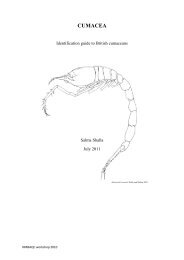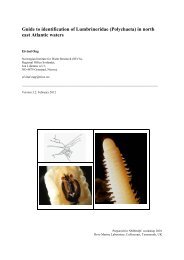s A Field Guide to the British Seaweeds - NMBAQC
s A Field Guide to the British Seaweeds - NMBAQC
s A Field Guide to the British Seaweeds - NMBAQC
You also want an ePaper? Increase the reach of your titles
YUMPU automatically turns print PDFs into web optimized ePapers that Google loves.
Heterosiphonia plumosa<br />
Plant filamen<strong>to</strong>us and quite bushy with a polysiphonous<br />
cylindrical main axis and monosiphonous and short<br />
branching. Fronds generally wide spreading giving a<br />
slightly delicate fea<strong>the</strong>r-like appearance accentuated by<br />
<strong>the</strong> short and numerous tufted branchlets which may be<br />
simple or forked. It is bright pink in colour, pinnate and<br />
flattened, growing up <strong>to</strong> 20cm long. It is found in<br />
rockpools within <strong>the</strong> lower lit<strong>to</strong>ral and sublit<strong>to</strong>ral fringe<br />
and often on growing on o<strong>the</strong>r algae in particular <strong>the</strong><br />
stipes of kelp.<br />
Hildenbrandia rubra<br />
This is a prostrate species growing<br />
as a crusts on rock surfaces<br />
appearing as a dark red stain. Plants<br />
may be quite extensive covering a<br />
vast area of rock and is found<br />
throughout <strong>the</strong> lit<strong>to</strong>ral region.<br />
Reproductive bodies may be visible<br />
within pits under magnification. Very<br />
common and easily distinguished<br />
from o<strong>the</strong>r encrusting algae.<br />
Flattened fea<strong>the</strong>r-like appearance<br />
of Heterosiphonia showing<br />
numerous small tufted branchlets<br />
Hildenbrandia as a<br />
dark red stain on rock<br />
surfaces very different<br />
from o<strong>the</strong>r,<br />
calcareous encrusters




